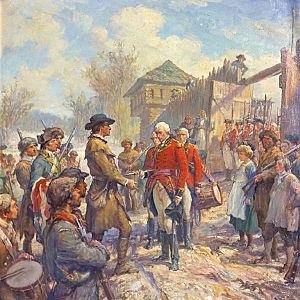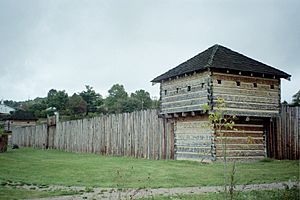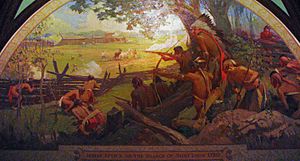Western theater of the American Revolutionary War facts for kids
Quick facts for kids Western theater |
|||||||
|---|---|---|---|---|---|---|---|
| Part of the American Revolutionary War, American Indian Wars | |||||||
 The Fall of Fort Sackville, Frederick C. Yohn, 1923 |
|||||||
|
|||||||
| Belligerents | |||||||
Shawnee Miami Lenape Seneca Wyandot |
|||||||
| Commanders and leaders | |||||||
Blackfish † Captain Pipe |
|||||||
| Strength | |||||||
| 700+ | 600+ | ||||||
| Casualties and losses | |||||||
| 120+ | 40+ | ||||||
The Western theater of the American Revolutionary War was a major part of the war. It took place in the lands west of the Appalachian Mountains. This area included what is now the Ohio Valley, the Great Lakes, and parts of what became Kentucky and Tennessee. The fighting involved American settlers, Native American tribes, and their British allies. Spain also joined the Americans later in the conflict.
Contents
Why the Western War Started
After the French and Indian War ended in 1763, Great Britain gained control of a huge area. This land stretched from its Atlantic colonies all the way to the Mississippi River. To prevent problems between settlers and Native Americans, the British made a rule. The Royal Proclamation of 1763 said colonists could not settle west of the Appalachian Mountains.
But many settlers and land buyers didn't like this rule. So, in 1768, the British made two treaties with Native Americans. These treaties, the Treaty of Fort Stanwix and the Treaty of Hard Labour, opened up land south of the Ohio River for settlement.
As the American Revolution got closer, things became tense in the Ohio Valley. Britain moved many soldiers from the West to the East Coast. This made it easier for settlers to move onto Native American lands illegally. In 1774, a group of settlers killed thirteen Native American women and children. This event, called the Yellow Creek massacre, angered the Mingo leader Tachnechdorus and the Shawnee. They felt they had not been paid fairly for their lands.
Most Native American groups living in the Ohio Valley, like the Shawnee, Mingos, Lenape, and Wyandots, were not part of the 1768 treaties. They were upset with the Iroquois for selling their lands. The Shawnee tried to unite other western Native American nations to protect their lands. However, the British and Iroquois worked to keep other nations from joining the Shawnee.
In 1774, a conflict called Lord Dunmore's War broke out. The Shawnee fought the Virginia militia with few allies. After Virginia won, the Shawnee had to accept the Ohio River as a boundary. But some Shawnee and Mingo leaders did not agree. They continued to fight when the American Revolutionary War began in 1775.
Early Years: 1775 to 1776
At first, both the British and the Americans wanted Native Americans to stay out of the war. In October 1775, American and Native American leaders met at Fort Pitt. They agreed to keep the boundary set by Dunmore's War.
However, some Native American leaders, like Chief Blackfish (Shawnee) and Pluggy (Mingo), raided settlements in Kentucky. They hoped to make the settlers leave. Virginia's governor, Patrick Henry, wanted to fight back. But he worried his militia might attack neutral Native Americans by mistake.
Native American groups like the Shawnee and Lenape became divided. Some leaders, like White Eyes (Lenape) and Cornstalk (Shawnee), wanted to stay neutral. Others, like Buckongahelas (Lenape) and Blue Jacket (Shawnee), chose to fight the Americans.
In Kentucky, settlers and hunters faced many attacks. Many left and went back East. By late 1776, fewer than 200 colonists remained in Kentucky. They mostly stayed in strong forts like Boonesborough and Harrodsburg. In December 1776, Pluggy was killed during an attack on McClellan's Station.
War Heats Up: 1777

In 1777, the British started a major attack from Canada. To help this effort, British leaders in Detroit began to arm Native American war parties. These groups raided American settlements in what is now Kentucky, West Virginia, and Pennsylvania. Many American settlers were killed.
The fighting became even more intense after American militiamen killed Cornstalk in November. Cornstalk was a leading voice for Shawnee neutrality. Even with all the violence, many Ohio Native Americans still hoped to stay out of the war. This was hard because they were caught between the British in Detroit and the Americans along the Ohio River.
American Push: 1778 to 1779
In the early war years, Virginia tried to protect its western border. Militiamen guarded three forts along the Ohio River: Fort Pitt, Fort Henry, and Fort Randolph. But this defense didn't work well. Native American raiding parties simply went around the forts. In 1778, the Americans decided they needed to go on the attack to secure their border.
In September 1778, the United States made the Treaty of Fort Pitt with the Lenape. This treaty aimed to get Lenape support for an attack on Detroit. However, the campaign was stopped after the death of Lenape leader White Eyes.
Problems at Fort Pitt
The first American attack into the Ohio Country was a disaster. In February, General Edward Hand led 500 Pennsylvania militiamen from Fort Pitt. They planned a surprise winter march to Mingo towns where the British stored supplies. Bad weather stopped them from reaching their goal.
On the way back, some of Hand's men attacked peaceful Lenape. They killed one man and several women and children. This included relatives of the Lenape chief Captain Pipe. Because only non-fighters were killed, the attack was mockingly called the "squaw campaign."
General Hand also faced problems with colonists who supported the British. In March, three men who knew the British and Native Americans well left Pittsburgh. They joined the British and Native American side. These men were Simon Girty, Matthew Elliot, and Alexander McKee. All three became very useful to the British. Facing criticism, Hand resigned in May.
Building Forts and Treaties
After the war grew in 1777, Americans on the western frontier asked the Continental Congress for help. Congress suggested sending two regiments of the Continental Army to the West. They also called for a fort to be built on the Native American side of the Ohio River. This was meant to be the first step in a plan to attack Detroit.
To build a fort in the Ohio Country, the Americans needed the Lenape's permission. In September 1778, Americans signed the Treaty of Fort Pitt with the Lenape. This led to the building of Fort Laurens along the Tuscarawas River.
But American plans quickly went wrong. White Eyes, the Lenape leader who made the treaty, was likely killed by American militiamen in 1778. His rival, Captain Pipe, eventually left the American alliance. He moved west and started getting help from the British in Detroit. Also, because of heavy fighting in other areas, Congress could not send enough soldiers for the Detroit attack. Fort Laurens was abandoned in 1779.
Clark's Illinois Campaign
In late 1778, George Rogers Clark, a young Virginia officer, started a campaign. He aimed to take the lightly guarded Illinois Country from the British. With a group of volunteers, Clark captured Kaskaskia on July 4. He later secured Vincennes.
Vincennes was then recaptured by General Henry Hamilton, the British commander at Detroit. In February 1779, Clark marched to Vincennes in a surprise winter attack. He captured Hamilton himself.
American frontiersmen called Hamilton "the Hair-buyer General." They believed he encouraged Native Americans to kill American civilians. Because of this, Governor Thomas Jefferson wanted Hamilton tried. But British officials threatened to harm American prisoners of war. So, Jefferson agreed to exchange Hamilton for an American prisoner in 1781.
Even though Clark's forces captured some outposts, British forces kept control of Fort Lernoult (Detroit).
Big British and Native American Attack: 1780

Over the next few years, both sides launched raids. They usually targeted settlements. In the spring of 1780, British and Native American forces swept across the Midwest. They attacked St. Louis and Cahokia and Kentucky. But they were pushed back in both battles. In St. Louis, the British and Native American force was stopped by Spanish and French forces.
Hundreds of Kentucky settlers were killed or captured in Bird's attack. Within months, General George Rogers Clark fought back. He crossed the Ohio River and attacked Shawnee towns like Chillicothe and Piqua.
In the Illinois territory, French officer Augustin de La Balme gathered a group of French residents. They tried to take Fort Detroit. But this force was destroyed in November by the Miami under Chief Little Turtle. At the same time, Americans from Cahokia raided the nearly empty Fort St. Joseph. On their way back, British loyalists and Native Americans caught them.
1781: More Fighting
Spanish Governor Francisco Cruzat, in St. Louis, sent about 140 Spanish soldiers and Native Americans. Led by Captain Eugenio Pourré, they captured and looted Fort St. Joseph on February 12, 1781.
In late 1780, Clark met with Thomas Jefferson, the governor of Virginia. They planned a big attack on Detroit for 1781. Jefferson wanted Clark to lead 2,000 men. But finding enough men was hard. Most militiamen preferred to stay close to home.
Also, Colonel Daniel Brodhead refused to send men. He was planning his own attack against the Lenape. The Lenape had recently joined the war against the Americans. Brodhead marched into the Ohio Country and destroyed the Lenape capital of Coshocton in April. This made the Lenape even stronger enemies. It also took away men and supplies Clark needed for his Detroit campaign. Most Lenape fled to towns on the Sandusky River.
When Clark finally left Fort Pitt in August, he had only 400 men. On August 24, about 100 of his men were ambushed near the Ohio River. They were attacked by Native Americans led by Joseph Brant, a Mohawk leader. Brant's victory ended Clark's efforts to move against Detroit.
Between the fighters on the Sandusky River and the Americans at Fort Pitt were several villages of peaceful Christian Lenape. These villages were run by Moravian missionaries. The missionaries supported the American cause. They kept American officials at Fort Pitt informed about British and Native American activity. In September 1781, Wyandots and Lenape from Sandusky forced the Christian Lenape and missionaries to move. They went to a new village called Captive Town on the Sandusky River.
1782: "The Year of Blood"
In March 1782, 160 Pennsylvania militiamen rode into the Ohio Country. They hoped to find the Native American warriors who were raiding Pennsylvania settlements. These militiamen were very angry because a white woman and her baby had been brutally killed by Native Americans.
Williamson's men found about 100 Lenape, now known as the "Christian Munsee," at the village of Gnadenhütten. These Christian Munsee had returned to harvest crops they had left behind. The Pennsylvanians accused them of helping raiding parties. They then killed all 100 Christian Native Americans, mostly women and children.
Colonel William Crawford of the Continental Army came out of retirement. He led 480 volunteer militiamen, mostly from Pennsylvania. They went deep into Native American territory to surprise the Native Americans. But the Native Americans and their British allies from Detroit knew about the plan. They brought about 440 men to the Sandusky to fight the Americans.
After a day of fighting, the Americans were surrounded and tried to retreat. Most of them made it back to Pennsylvania. About 70 Americans were killed. Native American and British losses were very small.
During the retreat, Colonel Crawford and some of his men were captured. The Native Americans executed many of these captives. This was revenge for the Gnadenhutten massacre earlier that year. Crawford's execution was especially harsh.
The failure of the Crawford expedition worried Americans on the frontier. Many feared the Native Americans would be bolder and launch more raids. More defeats for the Americans were still to come. Because of this, for Americans west of the Appalachian Mountains, 1782 became known as the "Bloody Year."
On July 13, 1782, the Mingo leader Guyasuta led about 100 Native Americans and British volunteers into Pennsylvania. They destroyed Hannastown, killing nine settlers and capturing twelve. This was the worst blow by Native Americans in Western Pennsylvania during the war.
In Kentucky, Americans went on defense. Caldwell, Elliott, and McKee, with their Native American allies, prepared a major attack. Fort Estill was attacked by Wyandot Native Americans in March 1782. Colonel Benjamin Logan, the commander of the region, learned about the Wyandot warriors. The Native Americans, helped by the British in Detroit, had raided from Boonsborough past Estill's Station.
Captain Estill led 25 men to follow the Native Americans. They suffered a defeat known as Battle of Little Mountain on March 22, 1782.
In July 1782, over 1,000 Native Americans gathered at Wapatomica. But the attack was called off. Scouts reported that George Rogers Clark was preparing to invade the Ohio Country from Kentucky. The reports turned out to be false. Still, Caldwell led 300 Native Americans into Kentucky. They delivered a crushing defeat at the Battle of Blue Licks in August.
One of the last battles of the Revolutionary War was the Siege of Fort Henry in September 1782. As peace talks between the United States and Great Britain progressed, Caldwell was told to stop fighting. In November, George Rogers Clark struck a final blow in the Ohio Country. He destroyed several Shawnee towns, but caused little harm to the people.
Peace and What Came Next
The war in the Northwest ended in a "stalemate." This means neither side truly won. In the last years of the war, each side could destroy enemy settlements. But they could not stay and hold the land.
For the Shawnee, the war was a loss. Americans had successfully defended Kentucky. More settlers moved there, and valuable hunting grounds were lost. Native Americans had been pushed back from the Ohio River. They now lived mostly near Lake Erie. But Americans could not fully settle the abandoned lands because of fear of Native American raids.
News of the peace treaty arrived late in 1782. In the final treaty, Great Britain gave the Ohio Country to the United States. This happened even though "not a single American soldier was north of the Ohio River when the treaty was signed." Great Britain did not talk to the Native Americans during the peace process. The Native Americans were not even mentioned in the treaty.
The fighting in the West was very different from the big battles in the East. It had a lasting impact on American settlers and Native American nations. For the Native American nations resisting the loss of their lands, the fight would continue. This next conflict was called the Northwest Indian War. This time, they would fight without direct British support.
|


